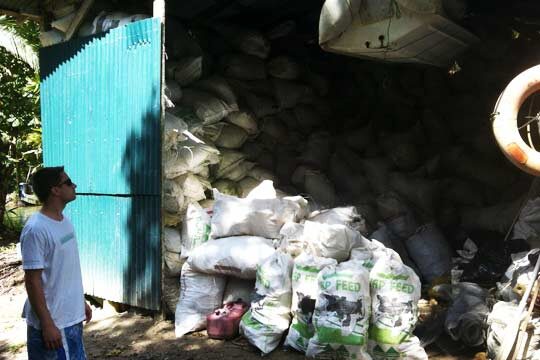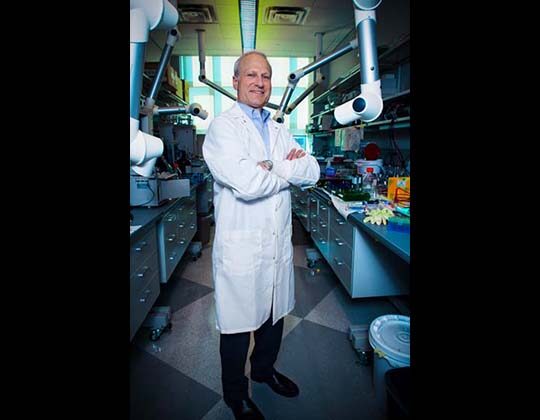Out of the Lab, Under the Sea
Professor David Sherman explores biochemical pathways of marine microorganisms with the goal of finding new drug candidates to treat infectious diseases and cancers. To collect the samples he needs for his work, he often trades his lab coat for a wet suit and travels to exotic locations rich in biodiversity resources. Sherman is a faculty member in the Life Sciences Institute (LSI). He also is the Hans W. Vahlteich Professor of Medicinal Chemistry and associate dean for research and graduate education in the College of Pharmacy. (Text by Laura Williams.)
-
Sea world
In May 2013 Sherman led a research expedition to Isla del Coco, a UNESCO World Heritage Site in Costa Rica. Sherman and his team collected sediment and marine invertebrates during a series of six dives. On land, the scientists acquired beetles, lichens, and additional microbiota from the island’s heavily protected rain forest. The microbiota is a resource for natural-product drug discovery and bioenergy resources. (Photo by Luis Acosta.)
-
Take it outside
Sherman is pictured here (second from right) at the onset of his May 2013 expedition to Isla del Coco. Five scientists accompanied him, including second-year medicinal chemistry graduate student Matt Okoneski (third from left). Four colleagues from the Costa Rica National Biodiversity Institute completed the team. Sherman is program director of the Costa Rica International Cooperative Biodiversity Group (ICBG). Research under the ICBG is in its second cycle of funding support through the NIH Fogarty International Center. Other support came from the National Institutes of Health, the National Science Foundation, the National Oceanic and Atmospheric Administration, the United States Department of Agriculture, and the Department of Energy. (Photo by Frank Gonzales.)
-
Good to go
Isla del Coco (a.k.a. “Cocos Island”) has 2,000-foot cliffs that rise sharply from the eastern Pacific Ocean. The researchers traveled for 36 hours on the 120-foot Undersea Hunter before reaching the island from Puntarenas, Costa Rica. The location’s “remote beauty and remarkable biodiversity beckons visitors to its waters and land,” Sherman says. Scientists favor it as well. After an arduous two-year process of seeking and obtaining research permits, Sherman’s team was proclaimed good to go in early 2013. They were cleared to collect up to 2,000 cumulative samples. (Photo by David Sherman.)
-
Go fish
On their initial “checkout dive,” researchers spotted a tiger shark, reef sharks, king angelfish, Panamic sergeant major fish, hawkfish, various types of wrasses, parrotfish, guineafowl pufferfish, thousands of blue-and-gold snappers, and more. They also collected 160 samples of microbiota. During the second dive, Sherman says he encountered fish as “fearless and numerous beyond my 36 years of experience.” The third dive, along the reef wall, attracted hammerhead sharks circling in a school with tuna, jacks, and more. (Photo by David Sherman.)
-
Swimming with sharks
Dive four plunged to a maximum depth of 112 feet in “very heavy current,” Sherman says. To avoid being swept away, divers had to descend and ascend along the anchor line. They landed on a sandy bottom and proceeded through a large crevasse to an open area at about 85 feet. Huge Galapagos sharks were circling while being cleaned of parasites by smaller fish. On dive five, two rangers accompanied the team to ensure their collection techniques were acceptable. The team came across a wall of dense vegetation that also had significant coverage of prized blue-green algae. Researchers collected vigorously before returning to the surface. (Photo by David Sherman.)
-
Getting schooled
Dive six was a light affair punctuated by the presence of a dozen or so small white-tip sharks, “seemingly curious about what we were up to and approaching within a meter or two before turning away,” Sherman says. The seventh dive centered around a wall extending 100 feet down to the ocean floor and 100 feet to a pinnacle above the surface. The wall was rich in blue-green algae, and four researchers worked for an hour collecting what they could. Sherman says he was “so focused on a narrow-view range that I started to reach toward a large eel concealed in a wall crevasse.” At that point, “I realized I better move on.” (Photo by David Sherman.)
-
Land ahoy
One day the team hiked to a remote section of the island teeming with feral pigs, deer, and rats. Among other things, the researchers collected passalid beetles in order to study the animal’s gut microbiome. The researchers also will mine sequencing data for gene products that are able to degrade cellulose—research with potential bioenergy-related applications. The team collected enough material for experiments planned over the next year. (Photo by Luis Acosta.)
-
Against the ropes
“We carried samples in our backpacks over the 2.5-kilometer trail,” Sherman says of the rain forest excursion. “Fortunately, there were rope hand-ladders to protect against falls.” The descent was incredibly dangerous, since the saturated ground and algae-covered rocks made every surface slippery. (Photo by Luis Acosta.)
-
All hands on deck
Sherman’s previous research with the International Cooperative Biodiversity Group has yielded more than 35,000 chemical extracts from marine and terrestrial microorganisms. Sherman and his colleagues in Costa Rica have found compounds with antibiotic, antiviral, antimalarial, anticancer, and other biological activities. Here, they are pictured on the deck of the Undersea Hunter during a break between dives. (Photo by Luis Acosta.)
-
Delicate balance
Rangers on daily patrols around Isla del Coco have confiscated hundreds of bags of fishing nets and thousands of fishhooks that were removed from the lines and netting. This material is evidence of the illegal fishing that threatens Isla del Coco’s delicate ecological balance. The island’s conservation zone and marine natural park extend 22.2 kilometers out from the shore. Illegal fishing in this zone, fueled in large part by the demand for shark-fin soup, has sent marine populations into serious decline. (Photo by David Sherman.)
-
Seeing stars
Throughout the expedition researchers swam with hammerheads, Galapagos sharks, white-tip sharks, and rays. On the final dive, the crew saw a huge marble ray and spiny urchins. Sherman puts the trip in perspective: “This ‘genomes-to-natural-products’ approach is an important next step in accessing the broad chemical diversity that exists within unculturable bacteria and fungi that make up the vast majority of the microbial world.” Think about that next time you fill your prescription. (Photo by David Sherman.)
-
Back in the lab
Since returning to his lab, Sherman has been extracting compounds from the samples he collected during the Isla del Coco expedition. He will add them to the chemical library in the LSI’s Center for Chemical Genomics, where they can be tested for effects against a range of diseases. (Photo by Craig Breil.)













